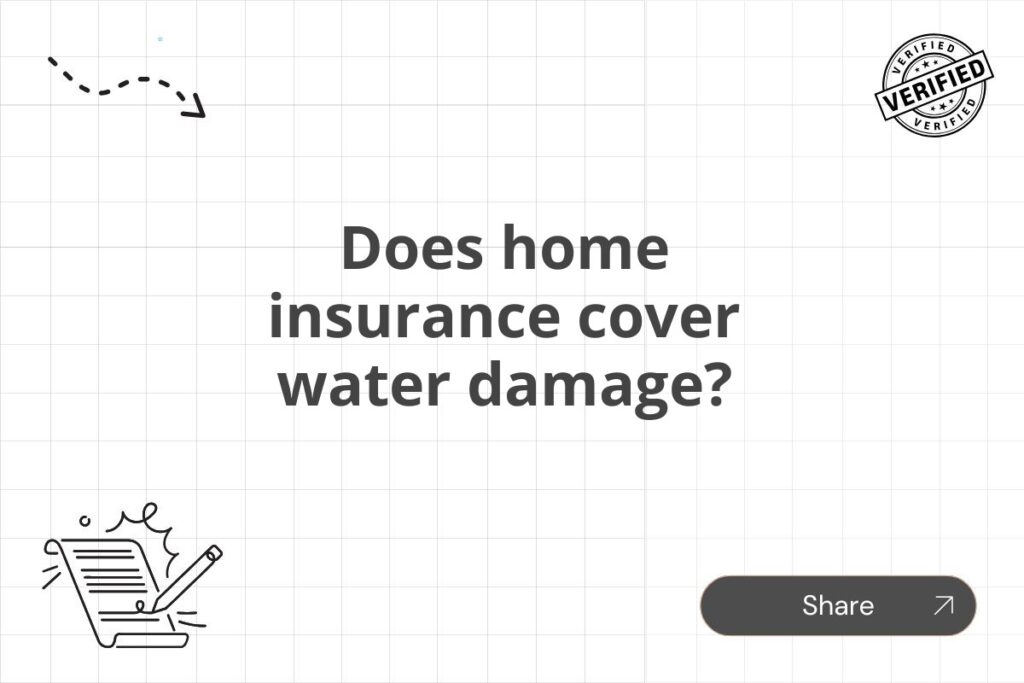Meta Description: Does your home insurance cover water damage? Find out what’s typically covered, what exclusions exist, and how to protect yourself from unexpected water-related losses. Learn about different types of water damage and how to file a claim.
Does home insurance cover water damage? It’s a question many homeowners ask, and the answer isn’t a simple yes or no. While many home insurance policies offer coverage for water damage, the specifics depend heavily on the
cause
of the damage. Understanding the nuances of your policy is crucial to ensure you’re adequately protected. This comprehensive guide will delve into the complexities of water damage coverage in home insurance, helping you navigate this potentially costly situation.
What Types of Water Damage are Typically Covered?
Home insurance policies generally cover water damage caused by sudden and accidental events, often referred to as “covered perils.” These typically include:
- Burst pipes: Water damage resulting from a sudden burst pipe is usually covered. This includes damage to your property and belongings.
- Severe storms and flooding (sometimes): While basic home insurance policies often exclude flood damage, many insurers offer flood insurance as an add-on. Coverage for storm-related water damage that isn’t considered flooding (e.g., heavy rain damaging a roof) is usually included. This is a key distinction to understand.
- Failing appliances: Water damage from a malfunctioning appliance like a washing machine or dishwasher is frequently covered, but only if the failure is sudden and accidental. A slow leak that goes unnoticed for weeks is less likely to be covered.
- Accidental discharge of water: This could encompass things like a water heater bursting or a toilet overflowing due to a malfunction, rather than gradual wear and tear.
What Types of Water Damage are Typically
Not
Covered?
It’s equally important to understand what your home insurance policy likely
won’t
cover when it comes to water damage. These exclusions can significantly impact your financial responsibility in the event of a water-related incident. Common exclusions include:
- Flooding: Flood damage is generally not covered by standard homeowner’s insurance. You’ll need a separate flood insurance policy to protect yourself from this significant risk, particularly if you live in a flood-prone area. Flood insurance is often subsidized through the National Flood Insurance Program (NFIP) in the United States.
- Gradual water damage: Slow leaks, seepage, or gradual deterioration from things like a leaky roof that isn’t addressed promptly are often excluded. This is often described as “wear and tear,” a term insurance companies use frequently to deny claims.
- Sewer backups: Backups from sewer lines are usually excluded from standard policies. Similar to flood insurance, you can purchase separate sewer backup coverage as an endorsement to your existing policy.
- Ground water: Water that enters your home from the ground, such as through cracks in the foundation, is typically not covered. This is often linked to poor construction or inadequate drainage.
- Negligence: If the water damage resulted from your negligence or failure to maintain your property (such as ignoring a leaking roof), your claim might be denied.
Understanding Your Policy’s Specifics
The information above provides a general overview. The specific terms and conditions of your home insurance policy will ultimately dictate the extent of your water damage coverage. Carefully review your policy documents, paying close attention to the following:
- Covered perils: This section lists the events that are covered by your policy. Make sure you understand what constitutes a “sudden and accidental” event.
- Exclusions: This section outlines the specific situations and types of damage that are
not
covered.
- Deductible: You’ll need to pay your deductible before your insurer covers the remaining costs of repairs or replacement.
- Coverage limits: Your policy will specify the maximum amount your insurer will pay for water damage.
What to Do After Water Damage Occurs
If your home experiences water damage, taking swift action is essential. This includes:
- Ensure safety: Prioritize the safety of yourself and your family. Turn off electricity to affected areas to prevent electrocution. If the damage is severe, consider evacuation.
- Document the damage: Take detailed photos and videos of the affected areas, including close-ups of the damage and the extent of the water intrusion.
- Prevent further damage: If possible, take steps to mitigate further damage, such as turning off water supplies and removing standing water.
- Contact your insurer: Report the damage to your insurance company as soon as possible. Follow their instructions for filing a claim.
- Keep records: Maintain meticulous records of all communication with your insurer, repair costs, and other relevant expenses.
Choosing the Right Coverage
The level of water damage coverage you need depends on several factors, including your location, the age and condition of your home, and your personal risk tolerance. Consider the following when choosing a policy:
- Evaluate your risk: Assess your vulnerability to various types of water damage, such as flooding or burst pipes.
- Review policy options: Compare policies from multiple insurers to find one that offers comprehensive coverage at a competitive price.
- Consider additional endorsements: Think about adding endorsements for flood, sewer backup, and other types of water damage not included in your standard policy.
- Increase coverage limits: If you have valuable possessions or a large home, ensure your policy’s coverage limits are adequate.
In conclusion, understanding whether home insurance covers water damage requires careful consideration of the cause of the damage and the specific terms of your policy. While many instances of sudden and accidental water damage are covered, it’s vital to understand the exclusions. By reviewing your policy thoroughly and taking proactive steps, you can safeguard your home and finances from the potentially devastating consequences of water damage.






















